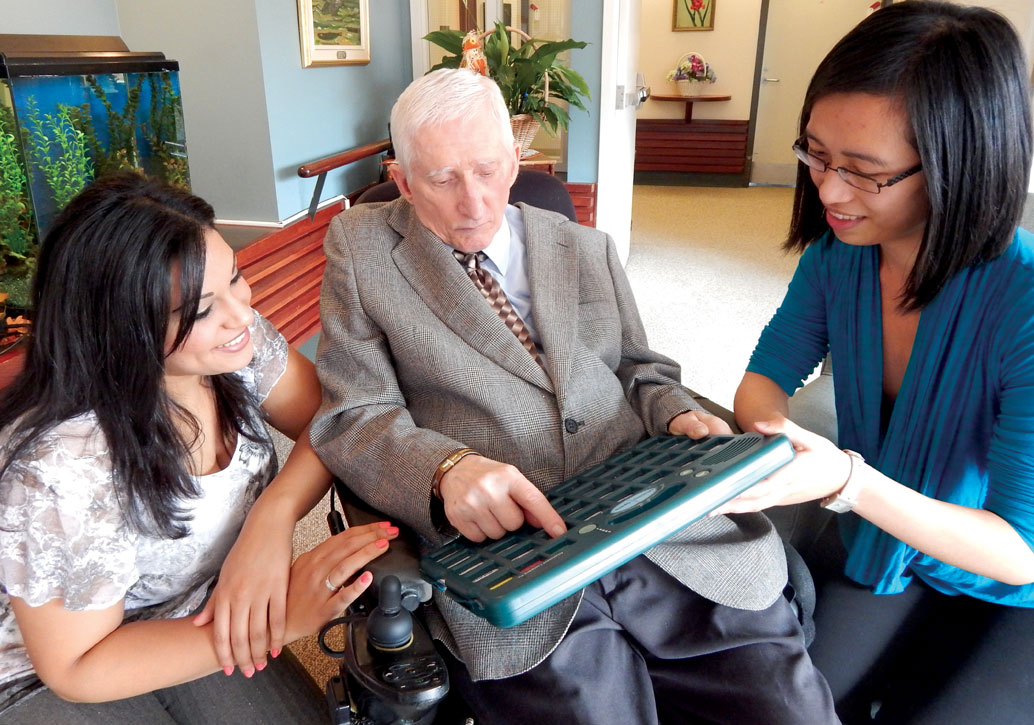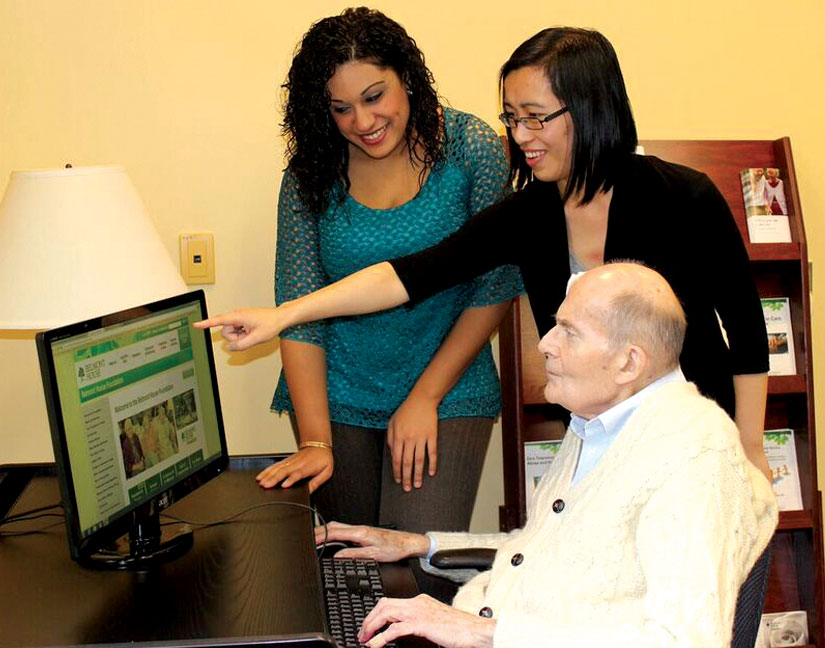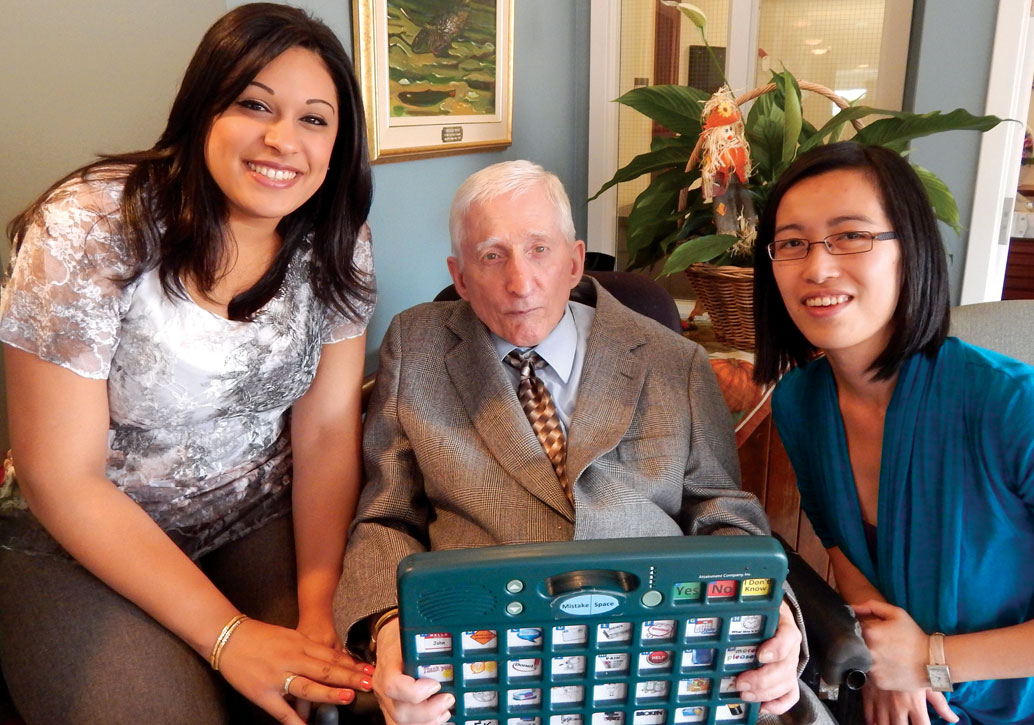Over Troubled Waters
By Marena Lamy
The retirement and home care industries are booming. With more supports than ever before, many older adults are able to live independently at home until much later in life than
previously. Consequently, they can be significantly older when they do eventually move into a retirement home or long-term care facility. Occupational therapists play an essential role in making these later transitions a success, with tasks including prescribing
assistive devices and making the appropriate environmental modifications.
To gain an understanding of these issues, we moved from our usual location as student occupational therapists at the University of Toronto’s Occupational Science and Occupational Therapy Department, and instead spent a summer at Belmont House, which offers long-term care and retirement living for Toronto’s seniors.
Our time at Belmont House highlighted the value of an individualized approach and the importance of “rapport building” to facilitate change, allow
the residents or tenants to sustain independence, provide comfort to families and reduce the staff workload. While there, we met some incredible individuals.
 Meet Mr. H
Meet Mr. H
Mr. H was a delightful 67-year-old man with Parkinson’s disease, difficulty speaking and several mental health challenges. Although he had much to offer the world, he hid behind an archaic alphabet board that he was using to communicate. Prior to working with
Mr. H, we were told that his family did not often visit and that he was spending too much time trying to make friends and communicate his needs. He knew what it was like to be constantly rushed and have people try to guess what he was saying, albeit incorrectly. We also learned that he had previously been given three high-tech, state-of-the-art communication devices, but that none of them had worked out.
As we began to build a relationship and find out more about Mr. H, we discovered that he had received limited training on the previous devices and had damaged them in frustration. We also learned that he wanted to be able to have longer talks with others when given the opportunity, because he did not have regular family visits.
Our goal: To improve Mr. H’s quality of life, through enhanced communication.
By taking the time to get to know Mr. H and through repetitive collaborating, we were able to identify a low-tech option with a sound output and the ability to record certain phrases. The “GoTalk 32+” device encompassed all of his requirements. Working with
Mr. H and everyone in his circle of care, we managed to personalize the device to handle his everyday needs, such as asking for a newspaper to read. To mitigate any frustration that Mr. H might feel at dealing with a new tool, we spent time practising with both him and his health care team.
The smile that lit up his face when we gave him the device after our final training session justified all of our hard work. With tear-filled eyes, he told us: “So far, it has been a godsend, it gets me back to society. The old way made me an outcast. I was considered a complete screw up…Now you have helped me. Thank you, both of you.”
Meet Mr. D
Working with Mr. D was particularly intriguing. Mr. D had experienced 21 falls in an eight-month time frame, and previous recommendations had had little impact. The combination of Mr. D’s stubborn nature, progressing Parkinson’s causing gait imbalances and a slipping memory were all strongly associated with his falls.
Mr. D tenaciously tried to live his life to the fullest and continue doing the activities he loved, such as attending Shakespearean plays at the Stratford Festival. However, he was very reluctant to comply with the recommendations staff had made in their post-fall assessments and we were curious to find out why. When meeting Mr. D, we made a strategic decision to focus on building a relationship rather than making recommendations, which up until that time he had rejected.
We learned that Mr. D was a scholar; he had a passion for reading books and using the computer. Our initial assessments identified a few areas where positive progress could be made.
• De-cluttering his apartment.
• Setting up medication reminders.
• Encouraging Mr. D to use his walker more consistently.
To ensure success, we used the “avenue of technology” as a means to facilitate our interventions. We started by working with Mr. D. to help him navigate his online banking, respond to emails and set up reminders for appointments and medications. It was sometimes challenging to justify the time and effort spent on these less crucial goals, compared with our ultimate goal of greater safety. Nevertheless, the effort was justified by Mr. D’s gratitude: “Many thanks for your kindness to an old fool who needs many a ‘bridge over troubled waters.’ You have enabled me to function in an incredibly baffling world of technology!”
In being client-centred and taking the time to help Mr. D explore his interests, and building a rapport in the process, Mr. D gradually became more open to our other recommendations.
We worked collaboratively to reorganize Mr. D’s bathroom
(a common area for falls). This opened up space for a chair, where he could sit for activities such as shaving. We also solved the mystery around Mr. D’s reluctance to de-clutter and remove his furniture. Many pieces had sentimental value, as they had belonged to a loved one and reminded him of his prior life. By gaining this understanding and spending time with Mr. D, we were able to persuade him to let go of some of his furniture to preserve his safety. This created a more spacious and walker-accessible living environment in which he could continue to pursue his interests. The result: A significant decline in the number and severity of falls. Mr. D taught us that, often, the time spent going the extra mile really does pay off in the long run.
A bridge over troubled waters
As demonstrated by both of our clients, occupational therapists serve as a bridge over troubled waters—helping individuals not only to age in place, but also to age well. In our experience, taking the time to develop a rapport and build relationships pays off in spades. The key to any encounter is to help the individual feel understood and genuinely cared for. Taking the extra time to listen to a client’s story—which might well be unrelated to the work you are doing—can serve as the segue to building trust and opening the client’s mind to new knowledge and a fresh attitude.
This project came about through a collaboration between Belmont House and the University of Toronto’s Occupational Science and Occupational Therapy Department. The placement was coordinated by Maria Elias, CEO of Belmont House, and Elizabeth Mullan, Chair of the Board of Directors and adjunct lecturer at the University of Toronto.













